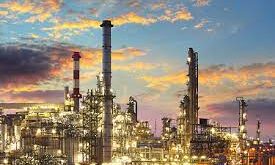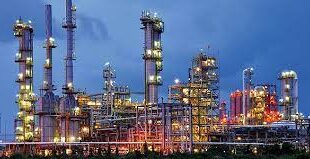Aramco plans to expand its downstream operations to tap into a $4 trillion chemicals market. Saudi Aramco
Saudi Arabia’s state oil company has made no secret of its intention to expand downstream. but its latest report to the market underlined the top priority the segment has in the company’s global master plan.
Saudi Aramco’s annual report on Thursday was. in large part. the typically bland corporate brochure. But amid the marking of another year of extraordinarily unchanged crude oil reserves (still around 260 billion barrels) and the usual goals for sustainability. the report contained several nuggets about its plans to expand downstream. especially in chemicals. The company stepped up its game massively last year with the start-up of its US$20 billion Sadara joint venture with Dow Chemical. the largest single-build chemicals plant in the world.
Aramco chairman. Khalid Al Falih. who is also Saudi Arabia’s oil minister. wrote: “For Saudi Aramco. the most notable feature of the Kingdom’s transformation will be the future offering of part of the company’s shares in local and international stock markets.”
Yet. there was no further mention of that initial public offering (IPO) of 5 per cent of the company. which has been the subject of intense international focus from bankers. investors. regulators and others. The report didn`t contain any financial information whatsoever. even though Aramco will have to disclose several years of past financial history if it chooses to list on either of its two preferred exchanges. in New York or London.
The company declined to comment about when it might publish such financial information.
But Mr. Al Falih also said that Aramco’s priority is “growing in new directions. including a stronger downstream portfolio with international refining. chemicals. and marketing opportunities.”
This was emphasised by the chief executive. Amin Nasser: “More recently. our vision has been to become the world’s leading integrated energy and chemicals company.”
In this area. which will be key in attracting public shareholders. there was more detail.
Though Aramco has been expanding downstream already. particularly within Saudi Arabia. it still is well short of its stated goal to be close to balance in upstream production and downstream refining capacity. Last year. it produced crude at a record 10.5 million barrels per day (bpd). while its refining capacity. including shares in joint ventures. was just over 3m bpd.
This latter figure has already increased in 2017 via overseas ventures. following the company’s buyout of Royal Dutch Shell’s 50 per cent of the Motiva refinery in Port Arthur. Texas. adding another half million bpd. Aramco also says it has hung onto the rights to use the Shell brand to sell its output in the region following the deal.
Aramco’s other major overseas downstream holding is in South Korea. where its nearly two-thirds share of S-Oil gives it capacity of nearly half a million bpd. The company says it has two projects underway in the country to create a more diverse product range .which include new facilities to produce polypropylene and propylene oxide. and to recover more ethylene.
Indeed. much of Aramco’s focus both overseas and domestically involves moving further downstream to petrochemicals.
The company says it has realised that “worldwide. the chemicals industry is a $4 trillion business. but the Gulf Cooperation Council’s (GCC) share of the global market for specialty chemicals. for example. is less than 2 percent. We therefore see significant opportunities to grow our downstream products portfolio.”
Aramco says that nearly a quarter of the output of the planned 400.000 bpd Jazan refinery on Saudi’s southwest coast will be aromatics – petrochemicals that are used to make products including detergents.
The company also notes that it is near to completing its delayed $9bn expansion of its Petro Rabigh refinery (a publicly-listed company. in which Aramco and Sumitomo of Japan each own 37.5 per cent). which will add ethylene – a precursor for many plastics products – and aromatics capacity.
There are also plans for an adjacent Petro Rabigh PlusTech Park. which Aramco says it hopes will attract $1bn of private sector investment from “conversion industries.” to make various plastics and other products from the refinery`s output. creating “more than 2.000 jobs.” To help the project along. Aramco has pledged to pay half the development costs. Likewise. its PlasChem Value Park adjacent to Sadara is expected to create another 1.500 jobs.
Crude oil production still dominates Aramco’s operations and its revenues. But as with other integrated oil majors. Aramco is positioning itself for a future where demand for transport fuels is lagging. but where demand for petrochemicals products is expected to continue to grow healthily.
 Iran Energy News Oil, Gas, Petrochemical and Energy Field Specialized Channel
Iran Energy News Oil, Gas, Petrochemical and Energy Field Specialized Channel



